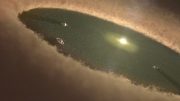
In the images, the dark areas represent the sea, which is thought to be composed of mostly methane and ethane. Most of the bright areas represent the land surface above or just beneath the water line. The mysterious bright feature appears off the coast below center in the middle and right images. Credit: NASA/JPL-Caltech/ASI/Cornell
New images from Cassini data show the appearance and evolution of a mysterious feature in Ligeia Mare, one of the largest hydrocarbon seas on Saturn’s moon Titan. The views, taken during three different Cassini flybys of Titan, show that this feature was not visible in earlier radar images of the same region and its appearance changed between 2013 and 2014.
NASA’s Cassini spacecraft is monitoring the evolution of a mysterious feature in a large hydrocarbon sea on Saturn’s moon Titan. The feature covers an area of about 100 square miles (260 square kilometers) in Ligeia Mare, one of the largest seas on Titan. It has now been observed twice by Cassini’s radar experiment, but its appearance changed between the two apparitions.
The mysterious feature, which appears bright in radar images against the dark background of the liquid sea, was first spotted during Cassini’s July 2013 Titan flyby. Previous observations showed no sign of bright features in that part of Ligeia Mare. Scientists were perplexed to find the feature had vanished when they looked again, over several months, with low-resolution radar and Cassini’s infrared imager. This led some team members to suggest it might have been a transient feature. But during Cassini’s flyby on August 21, 2014, the feature was again visible, and its appearance had changed during the 11 months since it was last seen.
Scientists on the radar team are confident that the feature is not an artifact, or flaw, in their data, which would have been one of the simplest explanations. They also do not see evidence that its appearance results from evaporation in the sea, as the overall shoreline of Ligeia Mare has not changed noticeably.
The team has suggested the feature could be surface waves, rising bubbles, floating solids, solids suspended just below the surface, or perhaps something more exotic.
The researchers suspect that the appearance of this feature could be related to changing seasons on Titan, as summer draws near in the moon’s northern hemisphere. Monitoring such changes is a major goal for Cassini’s current extended mission.
“Science loves a mystery, and with this enigmatic feature, we have a thrilling example of ongoing change on Titan,” said Stephen Wall, the deputy team lead of Cassini’s radar team, based at NASA’s Jet Propulsion Laboratory in Pasadena, California. “We’re hopeful that we’ll be able to continue watching the changes unfold and gain insights about what’s going on in that alien sea.”
The Cassini-Huygens mission is a cooperative project of NASA, the European Space Agency, and ASI, the Italian Space Agency. JPL, a division of the California Institute of Technology in Pasadena, manages the mission for NASA’s Science Mission Directorate, Washington. The radar instrument was built by JPL and the Italian Space Agency, working with team members from the United States and several European countries.









It’s now 2023. Do we know what this was?